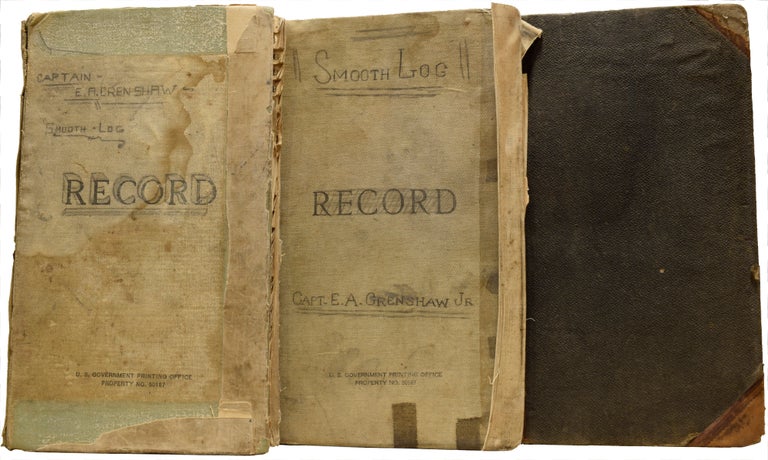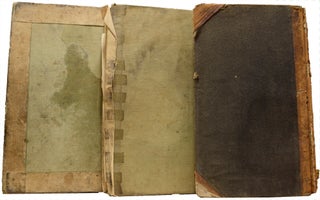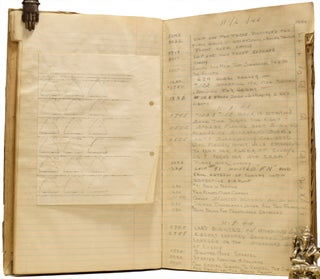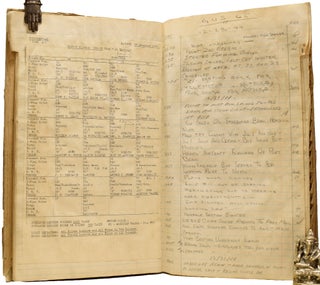
"Smooth Log" kept for Actions at Sea between 1943 and 1945 for Convoy UGS-43.
May 1943 to February 1945. [Second World War at Sea] ORIGINAL SHIP'S LOG. Three volumes. Folio (36 x 21cm). Two oblong cloth-bound ledger volumes with alphabetic tabs to fore-edge. Along with a similarly outwardly unprepossessing calf spined volume with annotated tabs to fore-edge (Strategy, Gunnery, Seamanship etc.) which proves to be a manuscript reference book of how to deal with storms, formulation of orders, procedure for getting underway and a number of other points of naval strategy and etiquette. Within the text of this volume are a number of meticulous ink illustrations and diagrams of engine parts, oil flow systems, filters, pumps and pistons neatly labelled in what I am tempted to call 'Naval Miniscule'. Scuffed, worn and stained (well, they were in a war), internally clean and legible with occasional staining or soiling to margins. The spines of both volumes are torn and repaired. Poor. The two volumes titled "Smooth Log", whilst a little tatty, are internally clean and filled out in pencil (in a number of hands) with meticulous timed and dated records of what happened to Capt. Crenshaw's convoy on any given day. On April 16th 1944, for example, we can see that ship #42, The Canfield "is a straggler, 18,000 yards astern" at 06:50 am; but by 1400 hours it has rejoined the convoy. On the 18th The Canfield has broken somewhere around the Cape Fear Outer Buoy, and that at 10:20 the next morning the Canfield "Accidentally fired 3 inch gun..." One can only assume that the captain of the Canfield was really popular with everyone else in the convoy. In addition to this kind of detail are numerous reports of fighters and bombers over the convoy, blimps regularly sighted, numerous reports of armed escorts casually chucking depth charges about, floating mines, ships joining and rejoining the convoy, changes of command (at one point a convoy falls under the command of a British Commodore, somewhere around Gibraltar, apparently an obstacle course of subs and floating mines) etc. In addition are detailed, tipped in convoy charts showing the positions, names and roles of all ships. One volume has colour signal and lighting diagrams tipped in at the rear showing signals for submarines, aircraft and the rather obscure flag signals for "I have cut a mine adrift with my paravanes"... these are conspicuously stamped "Confidential and Secret." Each volume is maybe half full of daily reports, perhaps 70-80 pages of manuscript log in all, not counting laid in convoy plans, lists of ships and other bits and pieces. Despite their somewhat salt-stained and dilapidated outward appearance they are inwardly fascinating and provide a wealth of detail regarding Pacific and Atlantic shipping convoys out of the US in time of war. The UGS convoys were a supply and material convoy group from the US to Gibraltar and Casablanca instituted as a result of Operation Torch, the Allied invasion of French North Africa "and was the responsibility of the USN. The convoys usually formed in Hampton Roads, though some ships departed from New York City and joined them directly after they had already sailed, in which case Hampton Roads would not appear in their voyage records. Escorts in the Atlantic were the USN's responsibility, with British escorts provided from the Mediterranean." "The UG convoys were a series of east-bound trans-Atlantic convoys from the United States to Gibraltar carrying food, ammunition, and military hardware to the United States Army in North Africa and southern Europe during World War II. These convoys assembled in Hampton Roads near the mouth of Chesapeake Bay and terminated in various North African locations as Axis forces retreated from 1942 through 1945." Arnold Hague: "The Allied Convoy System." UGS-43 was escorted by a number of warships at various points, including the USS Sellstrom, USS Tomich and USS Wiseman, both of whom were distinguished destroyers. Item #42868
Price: £1,750.00
Standard worldwide shipping is free for all orders over £200. UK standard postage is free for all orders. For expedited delivery, please contact us directly. See our full terms.








